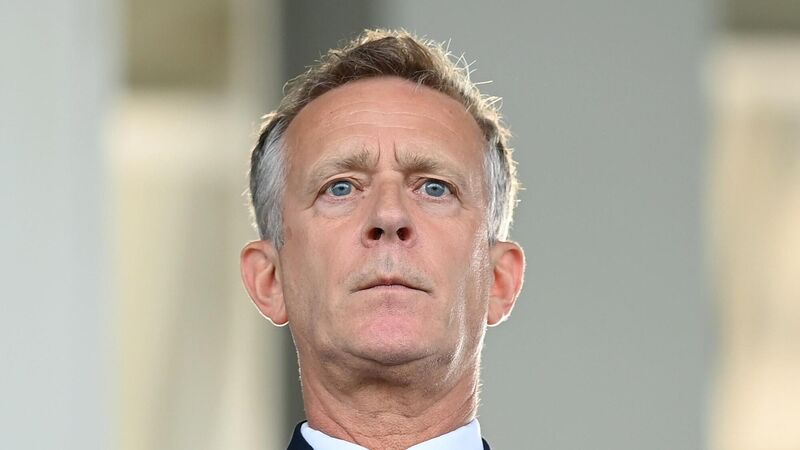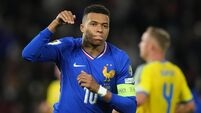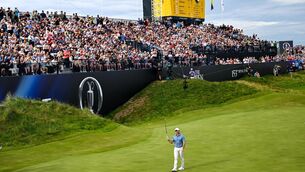Ian Mallon: Losing their shirts has left FAI with €5m chill

BETTER NEWS INCOMING?: FAI Chief Executive Jonathan Hill during the FIFA Women's World Cup 2023 Qualifier match between Slovakia and Republic of Ireland. Photo by Stephen McCarthy/Sportsfile
IN the 1,009 days since the FAI was put on notice that it needed to find a new sponsor for the Republic of Ireland men’s team, the association has lost €5.04m in commercial income.
In those 144 weeks, 114 of which have been spent without any shirt sponsorship revenue, the loss currently stands at €44k per week.
Such financial impacts demonstrate the challenge faced by the FAI as it strives to restore the brand and reputation of football following its destruction by the bad actors of the past.
There may be better news ahead with ongoing attempts to lure a large tech operator over the line, with tentative hopes that an announcement might be ready by the time the players meet up in 10 days.
Much of this optimism comes from market sources and from comments by FAI CEO Jonathan Hill during his last public press outing in July, when he declared that an upturn in sponsorship will occur in the season ahead.
Without specifying timelines, Hill said that the FAI’s forecasted rise in turnover from €42m to €50m will be due, in part, to “additional incremental commercial revenue from sponsors”.
There are three significant factors as to why the FAI has struggled to land a sponsor for what was once the biggest draw in Irish sport – brand, price and performance.
While the damage to the brand is clear, and it is taking longer for the corporate world to appreciate its recovery, the FAI’s valuation of the sponsorship bundle has been incompatible with market expectations.
Let’s go back to December 4, 2019, and the day the FAI was told by Three that it was severing its commercial ties with Irish football at the end of the 2019/20 season.
In the 30 weeks before the mobile operator’s departure, the FAI went out to market with a €2.5m price-tag in place, a higher price than what Three had paid.
Perhaps failing to realise the collateral commercial damage that the near-insolvency of 2019 had inflicted, the new Board’s approval of such a price proved a grossly inflated valuation.
In the summer of 2020, once the Three deal had formally ended and with no new suitors in the Boardroom, the FAI stuck with its new price, and doubled down on what it still believed to be the correct value.
That €2.5m pricing strategy remained for almost the next two years - 87 weeks to be precise – costing the association €4.182m in untapped commercial income.
During that period and despite lengthy discussions with Paddy Power, the FAI was told that it had overvalued its key sponsorship asset by almost €1m and should revise its annual fees to €1.57m.
However, once those negotiations had ended in acrimony, the FAI did not formally reduce the price, or if it did, it didn’t tell the market until March of this year – when it advertised a new rate of €1.66m.
Despite those reduced fees being in place for what has now been 27 weeks, this has still proven to be a hard sell with losses trending upward by an additional €862k.
Throughout this entire period of Boardroom indecision over the true value of the Irish men’s national team - which is bundled into an overall FAI headline sponsorship - there has been another factor in play: performance.
There is still great uncertainty about this team, and despite having a large and voluble support, Stephen Kenny’s sides have experienced performances and results which terrify corporates.
Jonathan Hill said those types of suitors who are nervous about the recent past “probably aren’t right to come into this environment”. No risk-averse sponsor will want another Luxembourg, Azerbaijan or Armenia on their corporate social media threads - but the Portugal and Scotland performances will certainly negate some of that jeopardy.
But the chief issue for the FAI remains regaining trust for the association. As Jonathan Hill put it, that is “part of the problem that we are trying to address”.
THAT the Government gives back all of the betting tax it earns from Irish punters to the horseracing and greyhound industry is a quirk in the Irish political and taxation system.
Last year that gambling duty amounted to €89m to the exchequer – or two per cent of total gambling income - which was then switched to the accounts of horse and dog racing.
Now the Federation of Irish Sport (FIS) has told the Government that it wants a piece of the lucrative betting industry pie – and is seeking a small percentage of betting tax for all other sports.
In a comprehensive five-point pre-budget submission to Government and the Department of Finance, the FIS also included an appeal for a portion of sugar tax to be allocated to sport.
“The Federation believe that the reallocation of funding from the betting duty of 2.25% and a redirecting of 4.5% of the sweetened sugar drinks tax would significantly enable the implementation of a support and educational body that would accelerate behavioural change and health benefits in each area,” it said.
To prepare its submission around betting tax, the Federation has brought in the services of Barry Grant of Extern Problem Gambling to prepare its appeal for a share of the racing industry’s fund.
Grant has been involved in similar lobbies to Government in the past for a cut of the revenue income to go towards gambling addiction services – which does not receive funding from any state agencies.
“I’ve been working on this with the Department of Finance in the past, trying to get money put into a pot for services (along with the Rutland centre),” he told The Pitch.
“But I’m constantly being told that it never ringfences any taxation income, which is ironic given the current situation (with the horse and dog racing industry).
“I think it’s possible that we can get some of this income given to sport and the argument is there to be made around addiction and prevention in sports.
“Sports people are a high-risk group, and at a time that horseracing and greyhound racing are receiving all of this income there’s an argument to be made to extend it across all sports.”
RTÉ has signed a content partnership agreement with Twitter which will increase the value of its advertising during the FIFA World Cup in Qatar.
The activation will see an amplification of the national station’s digital coverage which allows advertisers to attach their ads to premium footage from the standout moments throughout the tournament.
The deal allows advertisers to run branded pre-roll video, increasing brand awareness during the most watched sports event in the world.
In communicating its use of Twitter’s ‘Amplify’ service, RTÉ has thrown out a number of stats to demonstrate the power of the social platform including:
• One third of Irish Twitter users cite watching and following sports as their primary reason for using social media.
• 32% of Irish Twitter users having watched sports highlights and clips on the platform in the past week.
• 64% of World Cup fans on Twitter say that they can find content there which isn’t available on any other platform.
RTÉ will show all 64 games of the World Cup live across RTÉ2 and RTÉ Player with almost 200 hours of coverage in total, including four matches per day during the group stage.
The tournament will end with the World Cup final taking place on December 18.









